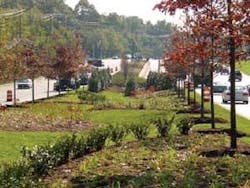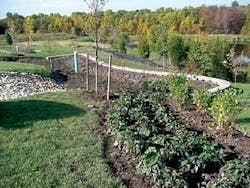Maryland County Uses EPA Grants to Manage Stormwater Naturally
By Greg Northcutt
Raided by a series of federal grants over the past four years, Prince George’s County, Maryland, is helping to lead the way in the use of low impact development Best Management Practices (BMPs) for reducing sediment and other pollutants in stormwater runoff from urban areas.
The county, part of the Washington, DC, metropolitan area, is using the U.S. Environmental Protection Agency (EPA) grants in its efforts to help clean up the Anacostia watershed. The funds are being used to demonstrate the effectiveness of BMPs that take advantage of a site’s natural features to store and infiltrate stormwater runoff. Such low impact development techniques are designed to reduce the erosive impacts of stormwater runoff and pollutants carried in the water. These BMPs include reduction in impervious surfaces, infiltration of runoff, dispersion of water flows and soil remediation among other practices.
The demonstration projects, which are being funded by the grants, serve as models for other municipalities, notes Mow-Soung Cheng, assistant associate director of the county’s Environmental Services Division, Department of Environmental Resources.
This year, the grant totaled $1.1 million dollars. Part of the funds are being used to support trash management projects. Along with benefiting water quality in the Anacostia watershed, this funding supports the goal of a trash-free Potomac watershed, according to Donald Welsh, regional administrator for EPA’s mid-Atlantic region.
Dealing with Development
The Anacostia River is one of the most degraded rivers in the United States, reported Frank Ciambrano, a project officer for the Water Protection Division of the EPA’s Mid-Atlantic Region in Philadelphia, Pa. The Anacostia River, a freshwater tidal system, is a tributary of the Potomac River and part of the Chesapeake Bay. It drains the urban watershed, which encompasses 456 km2 (176 mi.2) in Maryland and DC.
According to Ciambrano, specific ecological problems in the Anacostia watershed have largely resulted from an expanding human population and the associated changes in land use and land cover. Today, almost one million people live in this watershed. The ongoing loss of open space, forest and wetlands, the discharges of combined sewer overflows and industrial waste, the prior alterations of stream flow, and increases in nonpoint source pollution along with trash, have all contributed to the decline in the water quality of the watershed.
During the 1980s, Prince George’s County focused on the use of conventional BMPs, such as stormwater management ponds and stream and wetland restorations, to remove sediment and attached chemicals as well as oil, grease and other pollutants from stormwater runoff in the Anacostia watershed. However, by themselves, these practices didn’t achieve the desired level of pollution control, noted Cheng.
Alternative technologies, such as low impact development practices, were explored.
“In the 1990s we started promoting those practices and developing design strategies,” said Cheng. “We began conducting pilot studies to demonstrate to cities and other jurisdictions how low impact development technology can be used to treat stormwater runoff.”
Those studies, in turn, attracted the attention of EPA, which helped the county in seeking the grants. So far, the county has received a total of $5 million in EPA grants to support a variety of low-impact development practices.
A Team Effort
In addition to installing demonstration projects, the money has been used for related activities, including the first national conference on low impact development, which was held at the University of Maryland (College Park, MD) in 2004.
An urban watershed like this one comprises a number of municipalities, which contribute to the water pollution problem, Cheng said. Usually it takes a joint effort with many public and private partnerships to address the problem effectively.
Consequently, Prince George’s County is developing these low-impact projects in conjunction with a variety of government agencies. They include municipalities, high schools, regional parks, the University of Maryland, neighboring Montgomery County, Washington, DC, and the Maryland Department of Environment. Projects include the use of practices, such as bioretention facilities, rain gardens, grass swales and bayscaping (a landscaping technique that features plants requiring less fertilizer, watering or pesticides), that use the chemical, biological and physical properties of plants, microbes and soils to filter or hold pollutants from stormwater runoff. In addition, the projects are being monitored to assess their effectiveness in improving water quality.
Cheng says the idea is to create a natural pollutant-controlling environment that doesn’t require mowing or the use of fertilizers to keep it looking attractive.
“We’re also demonstrating different types of soil amendments to increase voids which will increase infiltration of runoff into the soil and recharge of the groundwater.”
About the Author:
Greg Northcutt is president of Northcutt Communications Inc., an editorial services firm in Port Orchard, WA, which has been covering environmental issues and the construction industry since 1988. He can be contacted at [email protected].


